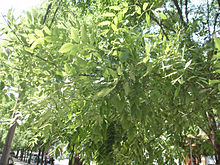bio.wikisort.org - Plant
Styphnolobium is a small genus of three or four species of small trees and shrubs in the subfamily Faboideae of the pea family Fabaceae, formerly included within a broader interpretation of the genus Sophora. It was recently assigned to the unranked, monophyletic Cladrastis clade.[1][2][3] They differ from the genus Calia (mescalbeans) in having deciduous leaves and flowers in axillary, not terminal, racemes. The leaves are pinnate, with 9–21 leaflets, and the flowers in pendulous racemes similar to those of the black locust. Necklacepod is a common name for plants in this genus.[4]
| Styphnolobium | |
|---|---|
 | |
| Styphnolobium japonicum foliage | |
| Scientific classification | |
| Kingdom: | Plantae |
| Clade: | Tracheophytes |
| Clade: | Angiosperms |
| Clade: | Eudicots |
| Clade: | Rosids |
| Order: | Fabales |
| Family: | Fabaceae |
| Subfamily: | Faboideae |
| Clade: | Cladrastis clade |
| Genus: | Styphnolobium Schott |
| Type species | |
| Styphnolobium japonicum (L.) Schott | |
| Species | |
|
9; see text | |
| Synonyms | |
| |
Etymology
From Greek styphno-, stryphno- "sour, astringent" and lobion "pod", because of the fresh pods' pulp taste.[5]
Species
Styphnolobium comprises the following species:[6][7][8]
Section Oresbios
- Styphnolobium affine (Torr. & A. Gray) Walp., the coralbean or Eve's necklace is native to the southern United States in Texas, Oklahoma, Arkansas and Louisiana. It is a large shrub or small tree, growing to 5–7 m tall, with white or pale violet flowers. The seeds of this species are believed to be poisonous.[9] The sapwood leaches a yellow dye on contact with water.[10]
- Styphnolobium burseroides M. Sousa & Rudd
- Styphnolobium caudatum M. Sousa & Rudd is native to Nicaragua.
- Styphnolobium conzattii (Standl.) M. Sousa & Rudd
- Styphnolobium monteviridis M. Sousa & Rudd is native to Central America.
- Styphnolobium parviflorum M. Sousa & Rudd
- Styphnolobium protantherum M. Sousa & Rudd
- Styphnolobium sporadicum M. Sousa & Rudd
Section Styphnolobium
- Styphnolobium japonicum (L.) Schott, the pagoda tree (Chinese Scholar, Japanese pagodatree; syn. Sophora japonica), is native to eastern Asia (mainly China; despite the name, it is introduced in Japan), is a popular ornamental tree in Europe, North America and South Africa, grown for its white flowers, borne in late summer after most other flowering trees have long finished flowering. It grows into a lofty tree 10–20 m tall with an equal spread, and produces a fine, dark brown timber.
Uses
The pagoda tree is widely used in bonsai gardening. The Guilty Chinese Scholartree was a historic pagoda tree in Beijing, on which the last emperor of the Ming Dynasty, Chongzhen, hanged himself.
Styphnolobium japonicum (Chinese: 槐; pinyin: huái; formerly Sophora japonica) is one of the 50 fundamental herbs used in traditional Chinese medicine.
References
- Cardoso D, Pennington RT, de Queiroz LP, Boatwright JS, Van Wyk B-E, Wojciechowski MF, Lavin M (2013). "Reconstructing the deep-branching relationships of the papilionoid legumes" (PDF). S Afr J Bot. 89: 58–75. doi:10.1016/j.sajb.2013.05.001.
- Cardoso D, de Queiroz LP, Pennington RT, de Lima HC, Fonty É, Wojciechowski MF, Lavin M (2012). "Revisiting the phylogeny of papilionoid legumes: new insights from comprehensively sampled early-branching lineages". Am J Bot. 99 (12): 1991–2013. doi:10.3732/ajb.1200380. PMID 23221500. Archived from the original on 2017-08-28. Retrieved 2014-02-12.
- Wojciechowski MF (2013). "The origin and phylogenetic relationships of the Californian chaparral 'paleoendemic' Pickeringia (Leguminosae)". Syst Bot. 38 (1): 132–142. doi:10.1600/036364413X662024. S2CID 86331839.
- USDA, NRCS (n.d.). "Styphnolobium". The PLANTS Database (plants.usda.gov). Greensboro, North Carolina: National Plant Data Team. Retrieved 4 December 2015.
- "Styphnolobium". Kew. Archived from the original on 2017-02-03. Retrieved 2017-01-23.
- "ILDIS LegumeWeb entry for Styphnolobium". International Legume Database & Information Service. Cardiff School of Computer Science & Informatics. Retrieved 13 February 2014.
- USDA; ARS; National Genetic Resources Program. "GRIN species records of Styphnolobium". Germplasm Resources Information Network—(GRIN) [Online Database]. National Germplasm Resources Laboratory, Beltsville, Maryland. Archived from the original on 24 September 2015. Retrieved 13 February 2014.
- Sousa-Sánchez M, Rudd VE (1993). "Revisión del género Styphnolobium (Leguminosae: Papilionoideae: Sophoreae)" [Revision of the genus Styphnolobium (Leguminosae: Papilionoideae: Sophoreae)]. Ann Missouri Bot Gard. 80 (1): 270–283. doi:10.2307/2399827. ISSN 0026-6493. JSTOR 2399827.
- "Lady Bird Johnson Wildflower Center - the University of Texas at Austin".
- "Dirt Doctor - Library Topics".
External links
![]() Media related to Styphnolobium japonicum at Wikimedia Commons
Media related to Styphnolobium japonicum at Wikimedia Commons
- Styphnolobium japonicum (as Sophora japonica)
- "Chinese Scholar Tree"
- The Evil God in the Pagoda Tree Japanese folktale with the Pagoda Tree at hyakumonogatari.com
На других языках
- [en] Styphnolobium
[es] Styphnolobium
Styphnolobium es un género de plantas con flores con nueve especies, perteneciente a la familia Fabaceae.Другой контент может иметь иную лицензию. Перед использованием материалов сайта WikiSort.org внимательно изучите правила лицензирования конкретных элементов наполнения сайта.
WikiSort.org - проект по пересортировке и дополнению контента Википедии